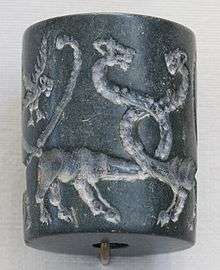Trialetian
| Period | Mesolithic |
|---|---|
| Dates | c. 16000 – c. 8000 BP |
| Major sites | Trialeti, Shanidar Cave, Huto and Kamarband Caves, Kotias Klde |
| Preceded by | Baradostian culture |
| Followed by | Shulaveri-Shomu culture |
| The Mesolithic |
|---|
| ↑ Upper Paleolithic |
|
| ↓ Neolithic |
Trialetian is the name for an Upper Paleolithic-Epipaleolithic stone tool industry from the area south of the Caucasus Mountains[1] and to the northern Zagros Mountains. It is tentatively dated to the period between 16,000 / 13,000 BP and 8,000 BP.[2] The name of the archaeological culture derives from sites in the district of Trialeti in south Georgian Khrami river basin. These sites include Barmaksyzkaya and Edzani-Zurtaketi.[3] In Edzani, an Upper Paleolithic site, a significant percentage of the artifacts are made of obsidian.[4] If the catastrophe that inspired the Biblical Noah’s flood can be dated to the end of the Younger Dryas period around 9600 BC, where Adam the first man starts in the Garden of Eden at the headwaters of the Euphrates and Tigris, which would be in northeastern Anatolia, and the ark landing at Durupinar near Mount Ararat,this culture could be related to the culture of the Antediluvian Patriarchs right up until the time of the Rainbow Covenant.
The Caucasian-Anatolian area of Trialetian culture was adjacent to the Iraqi-Iranian Zarzian culture to the east and south as well as the Levantine Natufian to the southwest.[5] Alan H. Simmons describes the culture as "very poorly documented".[6] In contrast, recent excavations in the Valley of Qvirila river, to the north of the Trialetian region, display a Mesolithic culture. The subsistence of these groups were based on hunting Capra caucasica, wild boar and brown bear.[7]
Literature
- Olivier Aurenche, Philippe Galet, Emmanuelle Régagnon-Caroline, Jacques Évin: Proto-Neolithic and Neolithic Cultures in the Middle East – the Birth of Agriculture, Livestock Raising, and Ceramics: A Calibrated 14C Chronology 12, 500-5500 cal BC, in: Near East Chronology: Archaeology and Environment. Radiocarbon 43,3 (2001) 1191–1202. (online, PDF)
- Stefan Karol Kozlowski: The Trialetian “Mesolithic” industry of the Caucasus, Transcaspia, Eastern Anatolia, and the Iranian Plateau. In: Stefan Karol Kozłowski, Hans Georg Gebel (ed.): Neolithic chipped stone industries of the Fertile Crescent, and their contemporaries in adjacent regions., Studies in Early Near Eastern Production, Subsistence and Environment 3, Berlin 1996, pg. 161–170.
References
- ↑ Anna Stolberg: Glossar In: Vor 12.000 Jahren in Anatolien. Die ältesten Monumente der Menschheit, Badisches Landesmuseum Karlsruhe (ed.), Stuttgart 2007, pg. 375–377, here: pg. 377.
- ↑ Frédérique Brunet: Asie centrale: vers une redéfinition des complexes culturels de la fin du Pléistocène et des débuts de l’Holocène, in: Paléorient 28,2 (2002) pg. 9-24.
- ↑ Nikolay I. Burchak-Abramovich, Oleg Grigor'evich Bendukidze: Fauna epipaleoliticheskoy stoyanki Zurtaketi, in: SANGSSR 55,3 (1969) pg. 32-33.
- ↑ Karine Khristoforovna Kushnareva: The Southern Caucasus in Prehistory. Stages of Cultural and Socioeconomic Development from the Eighth to the Second Millennium B.C., University of Pennsylvania Museum of Archaeology, 1997, pg. 9.
- ↑ Nach Henri de Cotenson in: Syria, tomus 80, 2003, 270-271, here: pg. 271; Besprechung zu Marcel Otte (ed.): Préhistoire d’Anatolie. Genèse de deux mondes. Actes du Colloque international, Liège, 28 avril-3 mai 1997. Liège 1998.
- ↑ Alan H. Simmons says the culture is "very poorly documented" (Alan H. Simmons: The Neolithic Revolution in the Near East. Transforming the Human Landscape, University of Arizona Press, 2011, pg. 53).
- ↑ Ofer Bar-Yosef: Upper palaeolithic hunter-gatherers in western Asia, in: Vicki Cummings, Peter Jordan, Marek Zvelebil (ed.): The Oxford Handbook of the Archaeology and Anthropology of Hunter-Gatherers, Oxford University Press, 2014, pg. 252–278, here: pg. 265 ff.
